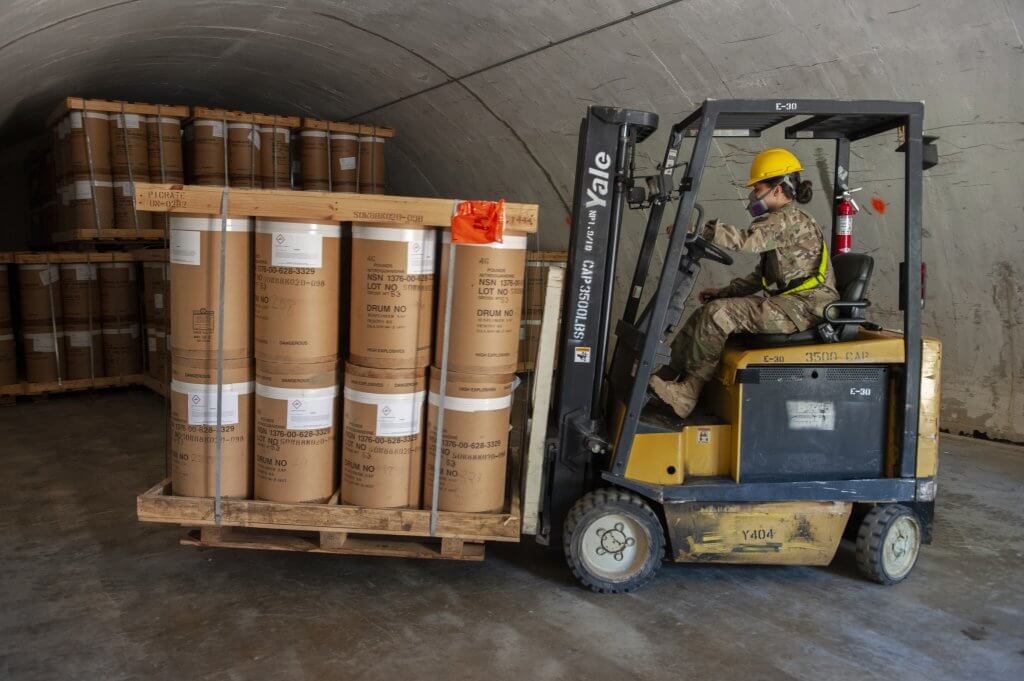Operation Patriot Press is an extensive campaign to utilize Army National Guard and Army Reserve sustainment units to support Army Materiel Command major subordinate commands through real-world missions. Maj. Gen. Allen Harrell, assistant deputy commanding general for National Guard Affairs, U.S. Army Materiel Command, took the lead in order to improve overall Army readiness and sustainment readiness across the reserve component.
The exercise kicked off earlier this year with roughly 425 personnel from Tennessee Army National Guard taking the planning and command role for Task Force Apollo. The mission objection was to move and store nitroguanidine — a substance used in propellants — from Milan Army Ammunition Plant to the Anniston Munitions Center while conducting company-level external evaluations.
Master Sgt. Lee Brock was the lead planner with preparation beginning in mid-2018 until the exercise started in May. He says the units were able to coordinate operations to complete the training within cost parameters of an annual training budget while achieving “an actual mission set.”
“To make this more funding friendly and get more bang for our buck, we were able to get all the units in line with their annual training events and keep the cost below a million dollars,” he said.
A typical day included briefs, truck inspections, and load certifications with convoys leaving in succession starting at 0600 and arriving at Anniston at 1430. The Guard units worked with specialized ammo handlers from the reserves.
“It was almost a total force integration-kind-of-operation. We had units not only from Mississippi, Alabama, but from New York City, Puerto Rico, and obviously our state (Tennessee),” he said. “We brought all of these players to the state of Tennessee basically three times within the year of planning to meet and plan.”
Brock says it provided the rare opportunity to conduct an external evaluation.
“What we were able to accomplish in this was not only getting tasked by the Army Materiel Command to do an actual mission that supports the government by moving ammunition from point A to point B, but we were able to do everything within an annual training budget and still give these people an external evaluation in their ready years, which is really hard to do in the National Guard and reserve world,” Brock said.
Sgt. 1st Class Joseph Vannoy, 432nd Transportation Company, commented on how professional the trainers and observer/controllers approached the event.
“Training was realistic, never had a no for any request from the unit. Smoke, blank ammo for all units. Far exceeded expectations to keep the training great for the unit,” he said.
The 1103rd Combat Sustainment Support Battalion from Alabama Army National Guard supported training by utilizing their two Transportation Companies, signal assets and medical support. The units transported over 160 containers from the origination point to the destination in order to facilitate the munitions movement.
“Participating in missions such as Patriot Press allow soldiers to train on their individual MOS while conducting a real world mission. These types of missions will increase unit readiness and retention efforts. I recommend continuation of reserve component units supporting these type of US Army Materiel Command lines of effort,” Lt. Col. Joel Traweek, 1103rd CSSB Commander, said.
The 230th Sustainment Brigade utilized the 266th Ordnance Company and 390th Seaport Company, both from Puerto Rico, to pack the munitions into containers and load them on trailers. By placing these soldiers at the depots, they were able to gain knowledge of operations not discussed in their training schools.
“This is my first annual training, so now I have a visual of how things move on a depot or at an ammunition storage area. It’s a good training experience that will help us be more proficient in the future,” 2nd Lt. Eduardo Santiago-Colon said.
Soldiers also gained experience in navigating real-life convoy operations, 1st Sgt. James Selph of the 1052nd Transportation Company says, with it being a “great environment to learn how to adapt and overcome challenges. This operation allowed junior soldiers to carry loads that most new drivers in the military would otherwise not be able to carry.”
Mission opportunities are currently being coordinated for ARNG and USAR sustainment units through 2024. For more information concerning NG and USAR FY 20/24 training opportunities, contact the RC MSO, Headquarters, U.S. AMC, 4400 Martin Road, Redstone Arsenal, AL 35898, COM: 256-450-6994, DSN: 320-6994 or usarmy.redstone.usamc.list.amc-rc-mission-support@mail.mil.

